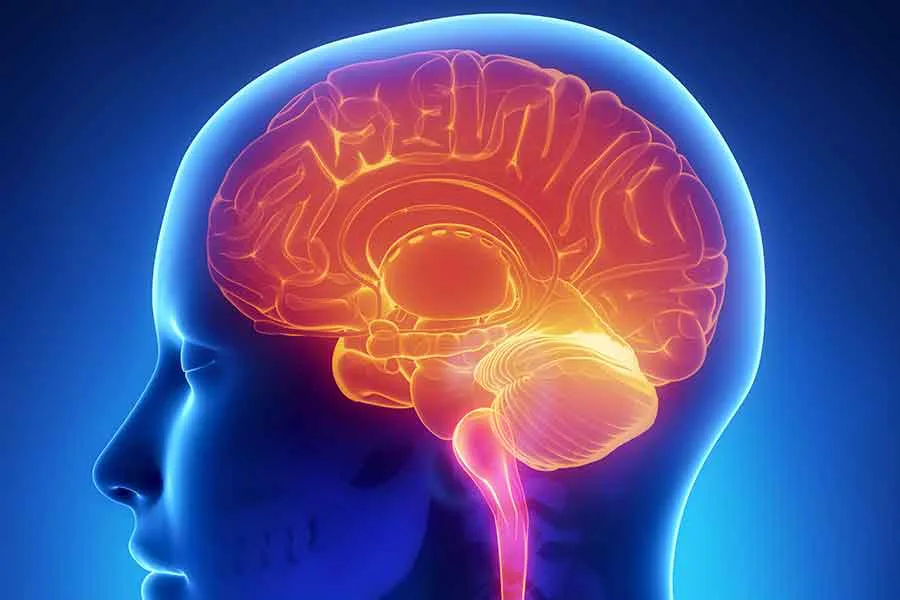Alcohol is a type of drug known as a Central Nervous System (CNS) depressant, meaning that it tends to decrease neuronal activity occurring in the brain and spinal cord. This decrease in activity contributes to some of the slow, sedating side effects the drug imparts on its consumers, like slurred speech and stumbling movements.
Alcohol is able to cause this decrease in neuron activity by increasing the activity of an important cell-signaling chemical in the nervous system called y-aminobutyric acid, otherwise known as “GABA.” This neurotransmitter is the body’s main inhibitory signaler. It moves around interacting with neurons and instructing them to “calm down” or decrease activity. The GABA system specifically works to relieve anxiety, act as a sedative-hypnotic, inhibit memory storage, and more. Alcohol simultaneously enhances the depressing effects of GABA by decreasing the activity of “glutamate,” the body’s most ubiquitous excitatory neurotransmitter. The more alcohol one drinks, the more insistent GABA becomes in telling the nervous system to calm down. Drinking a small amount can relieve anxiety and wear down inhibitions. Drinking past that point can cause sedation, then unconsciousness, then general anesthesia, and eventually death if the neurons critical to survival in the brainstem become inhibited.
How is Alcohol Different from Other Psychoactive Drugs?
Alcohol is different from other psychoactive drugs in the sense that it doesn’t target a specific neurotransmitter system. GABA and glutamate are ubiquitous chemical messengers and can move around affecting multiple systems. Different stages of behavioral sedation can be attributed to inhibition of different parts of the brain. For example, alcohol’s effect on the prefrontal cortex causes consumers to become more outgoing and less socially reserved. Its effect on the hypothalamic pituitary system causes a decrease in anxiety. Analgesia starts kicking in when the anterior cingulate or any of the body’s internal opiate systems are affected, and unconsciousness occurs when the ascending reticular activating system gets involved. In short, because alcohol affects many parts of the brain it can cause a wide variety of side effects for users.
What is BAC?
Drinkers can use Blood Alcohol Content (BAC) charts to roughly determine the sort of effects they can expect after consuming a certain number of drinks. The first areas of the brain to be affected are the decision-making centers such as the frontal cortex and the prefrontal cortex. Users with a BAC close to 0.1 can expect to have significantly slowed reaction time and trouble paying attention. The designation of “legally intoxicated” falls at 0.08, at which point lawmakers and physicians can safely assume that the user’s cognitive skills are impaired. At a level of 0.2, alcohol begins affecting the brain’s limbic structures, meaning that the user becomes emotional and may have impaired memory retrieval and/or forming abilities. At 0.3, alcohol begins affecting the body’s sensory systems. Between 0.4 and 0.5 the user can expect unconsciousness. At 0.65 or above, alcohol poisoning and death can occur.
The resilient human nervous system has protective mechanisms in place meant to prevent death from toxins such as alcohol. For example, unconsciousness often occurs before users can consume a fatal amount of alcohol.
In addition, when the body detects toxins floating around, the “area postrema” part of the brain is activated which causes the drinker to vomit and expel some of the body contaminants. Drinking games involving rapid consumption of alcohol give the protective mechanisms less time to activate, which decreases the likelihood of survival.

How Is Alcohol Absorbed?
If taken orally, alcohol can be absorbed in the body within a span of 30-90 minutes. Only about 10% of it gets absorbed within the stomach…most of it is absorbed in the duodenum, otherwise known as the upper part of the small intestine. Since the alcohol has to move through the digestive system, stomach content can greatly affect the absorption rate. For example, eating decreases the stomach’s gastric motility, which decreases the rate at which alcohol can move into the small intestine for absorption. Body fat and fluid content also play a role in alcohol kinetics. Men tend to have higher fluid content, less fat, and more muscle than women. Alcohol absorbs freely into all tissues except for fat, so women generally have a higher BAC than men. Additionally, the concentration of alcohol plays a role in absorption speed. Alcohol over 30-60 proof (15%-30% concentration) slows down the movement of alcohol into the small intestine so it stays in the stomach breaking down for a longer period of time. This brings into question the purpose of higher proof liquors…if the human body can’t absorb high concentrations of alcohol without the increased gastric breakdown, why do those potent varieties exist at all?
How is Alcohol Metabolized?
Metabolic enzymes called alcohol dehydrogenase and acetylaldehyde dehydrogenase are responsible for processing (oxidizing) alcohol. 15% of consumed alcohol is disposed of during a first pass of metabolism and never actually reaches the brain. This alcohol in broken down into acetic acid, which eventually goes on to be turned into dietary calories. For most drugs, increased consumption and concentration of the drug causes the body to increases the number of enzymes available to break down the drug, but alcohol for the most part does not cause this increase. Only one alcohol-related enzyme is upregulated in this way, called CYP450, so regular consumers of alcohol can sometimes drink more without feeling the effects because they can metabolize it faster. CYP450 is only a small piece of the process that is degradation of alcohol, though, so in reality metabolic rates stay constant regardless of consumption frequency. Disulfuriam has been widely publicized as a potential “cure for alcoholism” that works with these enzymes. This drug blocks the activity of acetylaldehyde dehydrogenase so acetylaldehyde builds up in the body. This compound is toxic so the Disulfuriam-user feels sick and theoretically less inclined to drink in the future. This drug works to a certain extent for some people, but is certainly not a “cure.”
What Can Drinking Do to the Body?
Chronic alcohol use can cause serious physical effects.
Putting alcohol in the body constantly causes the brain to put out more receptors to receive the ethanol molecules, and this upregulation can cause excitotoxicity and brain damage. Alcohol causes vasodilation, which some people refer to as simulating an “alcohol blanket” but this phenomenon actually results in heat loss.
Alcohol is especially toxic to developing brains, and Fetal Alcohol Syndrome can be detrimental or fatal to infants and/or neonates. Alcohol can cross many barriers in the body because ethanol is a small molecule, and this includes the placenta barrier so when pregnant women drink they are also supplying their baby with the toxin. Alcohol-use is also especially dangerous to children and teenagers because the brain is still developing. The growth of a protective covering in the brain called “myelin” peaks between ages 18-21 so alcohol has unrestricted access to many unprotected parts of the brain in youths.
Please call us here at Two Dreams if you find yourself struggling with alcohol-use; our lines are open 24 hours a day, seven days a week.
Two Dreams offers a safe, judgment-free place to start the healing process. There are many different ways to start managing addiction, and we understand that what works for one person may not necessarily work for another. We provide inpatient, intensive outpatient, and outpatient services based on the unique needs of each individual and the level of care needed. Our trained counselors, under the supervision of a physician, are happy to talk through these options with you and help decide which placement will best fit your needs. We ensure that the transitions into and out of treatment are as stress-free as possible by guiding you through each process step-by-step. Additionally, we provide step-down transition programs to help you shift out of the treatment center setting.
Our expert staff has been helping people with addiction for decades, so you can be sure that you and your loved ones will be in good hands. Dr. Andrea Barthwell, founder and CEO of Two Dreams, is widely regarded as one of the “Best Doctors in America” in the field of addiction medicine. She served as president of the American Addiction Society of Medicine (ASAM), as well as Deputy Director for Demand Reduction in the White House under President George W. Bush. Her renowned status and experience in the field have allowed her to shape Two Dreams into the outstanding recovery center that it is today—one that is able to provide state-of-the-art care and services to those in need. We are here to help you in any way that we can; we are on your side.
Sources Cited
Traynelis, Pharmacol Rev 62:405–496, 2010
Mol Neurobiol (2008) 37:126–141
Vizi, British Journal of Pharmacology (2010) 160 785–809
Kalia, K. et al. Lancet Neurol. 2008 Aug;7(8):742-55
Nestler, E.J., et al., Molecular Neuropharmacology, 2009
Buhler, Alcohol Clin Exp Res, Vol 35, No 10, 2011: pp 1771–1793
Nestler, Nat Neurosci. 2005 Nov;8(11):1445-9
Journal of Pediatrics, 1978, 92(1):64-67
Gogtay, Proc Natl Acad Sci U S A. 2004 May 25;101(21):8174-9
Paul, Arch Neurol. 2008;65(10):1363-1367
McSweeney, Alcohol Clin Exp Res, 33, 2009: 1278–1285
Ann. Rev. Psychol. 2008, 59:29-53
Zahr, N. M. et al. Nat. Rev. Neurol. 7, 284–294 (2011)
Buhler, Alcohol Clin Exp Res, Vol 35, No 10, 2011: pp 1771–1793
Guerri & Pascual, Alcohol 44 (2010) 15-26
Gorman, Linda. “CNS Depressants” PowerPoint presentation. Johns Hopkins University, Baltimore, MD. 17 Mar 2014.
